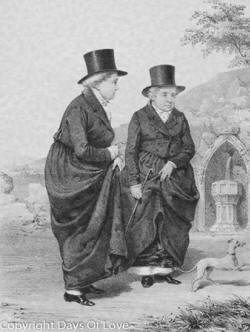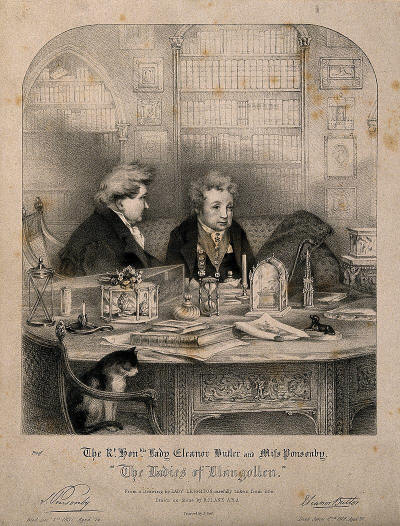

Partner Sarah Ponsonby, Mary Carryl
Queer Places:
Kilkenny Castle, Collegepark, Kilkenny, Co. Kilkenny, Irlanda
Plas Newydd, Hill St, Llangollen LL20 8AW, Regno Unito
St Collen, Denbigh LL16, Regno Unito
 The
"Ladies of Llangollen", Eleanor Butler and Sarah Ponsonby, were two
upper-class Irish women whose relationship during the late 18th and early
19th century scandalized and fascinated their contemporaries.[1]
Eleanor Butler referred to her beloved Sarah Ponsonby in her journals as
“my better half.” They established a home at Plas Newydd, which they
shared for forty years, sleeping in the same bed, signing their
correspondence jointly and addressing each other as "my Beloved". The twosome was actually a threesome: the ladies are
buried together in the graveyard of St Collen’s Church in Llangollen
together with their servant, Mary Carryl.
In 1796, Anna Seward published a poem
entitled Llangollen Vale, praising the vestal lustre of their sacred
Friendship.
The
"Ladies of Llangollen", Eleanor Butler and Sarah Ponsonby, were two
upper-class Irish women whose relationship during the late 18th and early
19th century scandalized and fascinated their contemporaries.[1]
Eleanor Butler referred to her beloved Sarah Ponsonby in her journals as
“my better half.” They established a home at Plas Newydd, which they
shared for forty years, sleeping in the same bed, signing their
correspondence jointly and addressing each other as "my Beloved". The twosome was actually a threesome: the ladies are
buried together in the graveyard of St Collen’s Church in Llangollen
together with their servant, Mary Carryl.
In 1796, Anna Seward published a poem
entitled Llangollen Vale, praising the vestal lustre of their sacred
Friendship.
After the departure of an unsatisfactory footman, all the servants and most of the domestic animals were female, including a little dog called Sapho. To John Lockhart, who saw them with ‘crop heads’, wearing men’s hats and huge shoes, they looked like ‘a couple of hazy or crazy old sailors’. They showed that two women could contract a ‘marriage’ and still be chaste. Eleanor and Sarah were famous for being a good example. The odd couple who went about their humble business and served tea to visitors were the acceptable face of that fashionable French scourge: sapphism. This was the implicit background to the idealization of the Ladies, the reason why the word ‘pure’ was so often attached to their friendship, for example in the odes of Anna Seward: ‘so pure a shrine’; ‘sacred Friendship, permanent as pure’; ‘pure Friendship’s spotless palm’. Wordsworth’s sonnet ‘To the Lady E. B. and the Hon. Miss P.’ (1824) is typical in politely catapulting their liaison into a realm of impenetrable chastity: On Deva’s banks, ye have abode so long; Sisters in love, a love allowed to climb, Even on this earth, above the reach of Time!
Not everyone however saw them as sexless maids. Hester Thrale called them ‘damned Sapphists’ and said that no woman would dare to spend the night at Plas Newydd without a man. Anne Lister made a pilgrimage to Llangollen in 1822 with Mariana Belcombe, and could not ‘help thinking that surely it was not platonic. Heaven forgive me, but I look within myself & doubt.’ Long before Colette described ‘les Dames de Llangollen’ in Le Pur et l’Impur (1932) as forerunners of modern lesbians, the Ladies of Llangollen, joined the pantheon of homosexual couples. When Lord Byron imagined himself and his beloved John Edlestone outshining other famous lovers, he included the Ladies in the list: ‘We shall put Lady E. Butler, & Miss Ponsonby to the Blush, Pylades & Orestes out of countenance, & want nothing but a Catastrophe like Nisus & Euryalus, to give Jonathan & David the “go by”.’
.jpg)

Plas Newydd, Llangollen
St Collen, Llangollen
St Collen, Llangollen
The Ladies’ marriage has been a bone of contention among social historians and queer theorists. The point was beautifully made by Colette in Le Pur et l’Impur. (The italicised phrase comes from Eleanor’s journal.) Two women who are very much in love do not avoid physical pleasure, nor a kind of sensuality that is more diffuse and yet more passionate than the spasmodic variety. This unresolved, undemanding sensuality that finds happiness in an exchanged glance, in an arm around the shoulder, in the smell of warm wheat that hides in hair – these delights of constant presence and routine are the source and justification of their fidelity. [. . .] Perhaps this love that is said to be an outrage to love evades the passing seasons and the ebbing of love on condition that it be governed with invisible severity and kept on a strict diet [. . .] – in such a way that by its grace half a century slips away like a day of sweetly enjoyed retirement.
Eleanor Charlotte Butler (11 May 1739 – 2 June 1829) was a member of the Butlers, the Earls (and later Dukes) of Ormond. Butler was considered an over-educated bookworm by her family, who resided at the Butler family seat Kilkenny Castle. She spoke French and was educated in a convent in France. Her mother tried to make her join a convent because she was remaining a spinster.
Sarah Ponsonby (1755 – 9 December 1831) lived with relatives in Woodstock, County Kilkenny, Ireland. She was a second cousin of Frederick Ponsonby, 3rd Earl of Bessborough, and thus a second cousin once removed of his daughter Lady Caroline Lamb.[note 1]
Their families lived two miles (3 km) from each other. They met in 1768, and quickly became close. Over the years they formulated a plan for a private rural retreat. It was their dream to live an unconventional life together.
Rather than face the possibility of being forced into unwanted marriages, they left County Kilkenny together in April 1778. Their families hunted them down and forcefully tried to make them give up their plans—but in vain.[3] They moved to Wales with a servant, Mary Caryll, who lived and worked for them without pay for the rest of her life, and who was buried in the same plot and memorialized on the same grave marker.[4][5]
Putting their plan into motion, they undertook a picturesque tour of the Welsh countryside, eventually settling in North Wales. Living first in a rented home in the village of Llangollen, they moved in 1780 to a small cottage just outside the village they called Plas Newydd or "new mansion".[6] They proceeded to live according to their self-devised system, though they could rely on only a modest income from intolerant relatives, and eventually a civil list pension. They 'improved' Plas Newydd in the Gothic style with Welsh oak panelling, pointed arches, stained glass windows, and an extensive library, in which they received their many guests.[5] They hired a gardener, a footman and two maids. This led to significant debt, and they had to rely on the generosity of friends.[3]
They devoted their time to hosting a range of friends and curious visitors, extensive correspondence, private studies of literature and languages, and improving their estate. Over the years they added a circular stone dairy and created a sumptuous garden. Eleanor kept a diary of their activities. Llangollen people simply referred to them as "the ladies".[3]
After a couple of years, their life attracted the interest of the outside world. Their house became a haven for visitors travelling between Dublin and London, including writers such as Anna Seward,[5] Robert Southey,[4] William Wordsworth,[4] Percy Shelley,[4] Lord Byron[4] and Sir Walter Scott,[4] but also the military leader the Duke of Wellington[4] and the industrialist Josiah Wedgwood;[4] aristocratic novelist Caroline Lamb,[4] who was born a Ponsonby, came to visit too. Anne Lister from Yorkshire visited the couple, and was possibly inspired by their relationship to informally "marry" her own close female friend.[7] Even travellers from continental Europe had heard of the couple and came to visit them, for instance Prince Hermann von Pückler-Muskau, the German nobleman and landscape designer, who wrote admiringly about them.[3]
The ladies were known throughout Britain, but have been said to have led "a rather unexciting life".[8] Queen Charlotte wanted to see their cottage and persuaded King George III to grant them a pension. Eventually their families came to tolerate them.
Butler and Ponsonby lived together for the rest of their lives, over 50 years. Their books and glassware carried both sets of initials and their letters were jointly signed. They both dressed strangely, in black riding habits and men's top hats; towards the end of their lives, visitors thought it was eccentric and outdated – especially the hair powder – but neighbors thought the clothes were practical for living outdoors.[4][5]
Rumors that they were in a sexual relationship floated around during their lives. In July 1790, The General Evening Post published an article under the title ‘Extraordinary Female Affection’. The article praised the Ladies’ ‘elegance, neatness and taste’, but it also raised the spectre of sexual identity: Miss Butler is tall and masculine, she wears always a riding habit, hangs her hat with the air of a sportsman in the hall, and appears in all respects as a young man if we except the petticoats which she still retains. Miss Ponsonby, on the contrary, is polite and effeminate, fair and beautiful. [. . .] Miss Ponsonby does the duties and honours of the house, while Miss Butler superintends the gardens and the rest of the grounds. According to Patricia Hampl, they were enraged by the article, and objected to the magazine's characterization to the point of consulting Edmund Burke over the possibility of suing the magazine for libel.[4]
In sharp contrast to the writings of their contemporary Anne Lister, there is nothing in their extensive correspondence or diaries that indicates a sexual relationship.[5] Some consider Butler and Ponsonby's relationship to be a Boston marriage, or a romantic relationship between two women who chose to live together and have "marriage-like relationships".[7] Others conclude that the two had a non-sexual romantic friendship. Norena Shopland says that modern criteria, designed to distinguish same-sex relationships from a romantic friendship, indicates that they had a sexual relationship.[9] According to Fiona Brideoake, the description of queer is more appropriate than the anachronistic and specific label of lesbian, particularly as queerness is a broad concept and significantly defined by its difference from typicality.[5] Brideoake also writes that their relationship was celebrated by other people as a form of mourning the relationships that they could not form.[5]
Mary Caryll died in 1809. Eleanor Butler died in 1829 at the age of 90. Sarah Ponsonby died two years later, age 76. They are all buried together at St Collen's Church in Llangollen.[4]
The ladies' house, Plas Newydd is now a museum run by Denbighshire County Council.
Butler's Hill, near Plas Newydd, is named in honour of Eleanor Butler. The Ponsonby Arms public house, a Grade II listed building on Mill Street in Llangollen,[10] claims to take its name from Sarah Ponsonby.[11]
My published books: